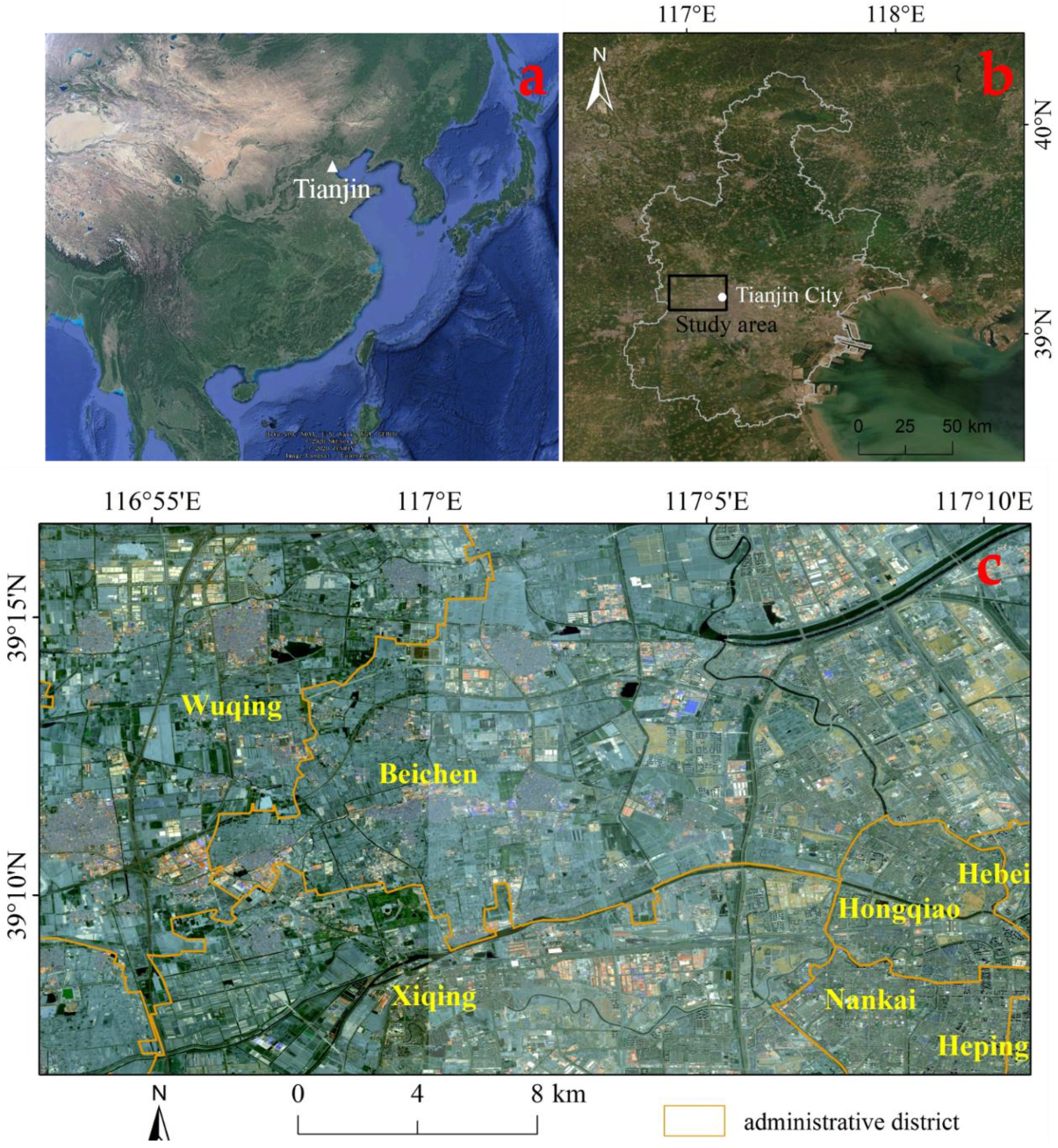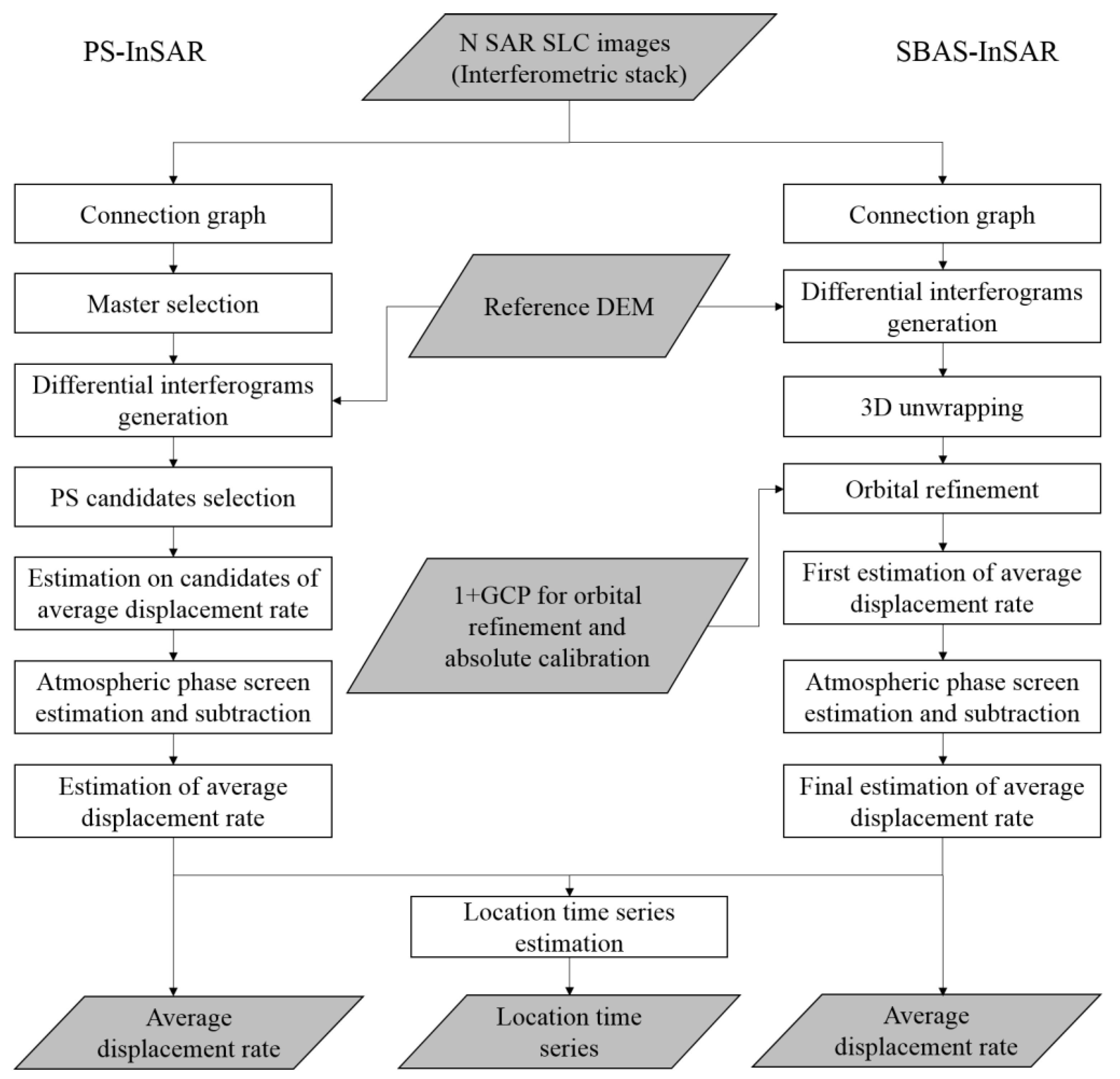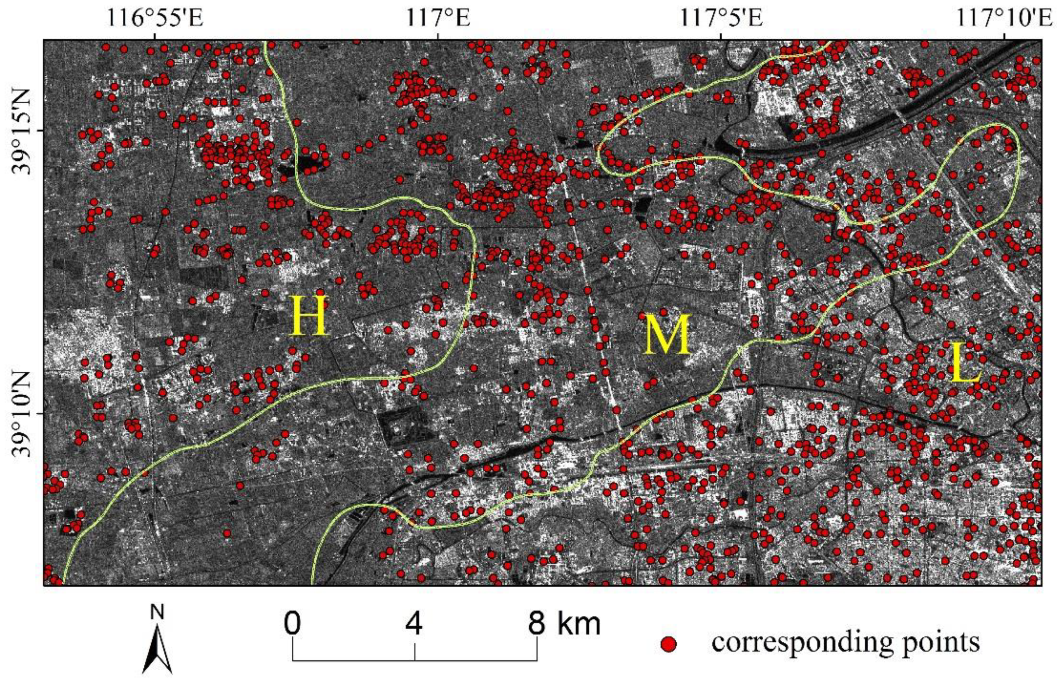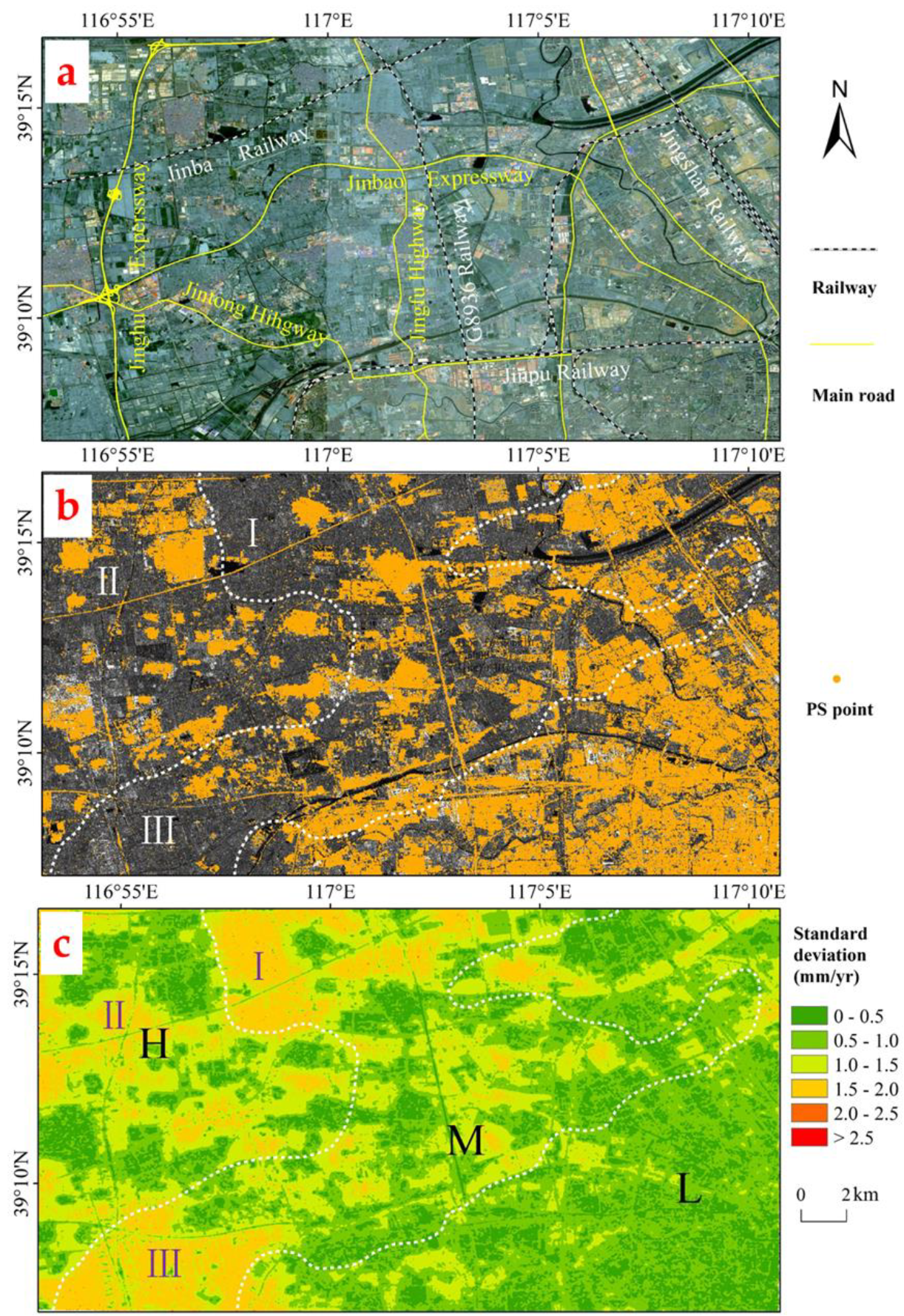Ground Subsidence Analysis in Tianjin (China) Based on Sentinel-1A Data Using MT-InSAR Methods
Abstract
1. Introduction
2. Materials and Methods
2.1. Study Area
2.2. Data Description
2.3. In-SAR Techniques
2.3.1. PS-InSAR
2.3.2. SBAS-InSAR
2.4. Cross-Comparison Analysis between PS and SBAS Methods
3. Results
3.1. Comparison of Results Obtained by the Two MT-InSAR Techniques and Field Validation
3.2. Comparison of Corresponding Points
4. Discussion
4.1. Comparison of the Two MT-InSAR Techniques
4.2. Recent Ground Subsidence Characteristics and Its Influencing Factors in Tianjin
4.3. Suggestions on Controlling Tianjin Suburbs Ground Subsidence
5. Conclusions
Author Contributions
Funding
Acknowledgments
Conflicts of Interest
References
- Ng, A.H.-M.; Ge, L.; Li, X. Assessments of land subsidence in the Gippsland Basin of Australia using ALOS PALSAR data. Remote Sens. Environ. 2015, 159, 86–101. [Google Scholar] [CrossRef]
- Zhou, L.; Guo, J.; Hu, J.; Li, J.; Xu, Y.; Pan, Y.; Shi, M. Wuhan Surface Subsidence Analysis in 2015-2016 Based on Sentinel-1A Data by SBAS-InSAR. Remote Sens. 2017, 9, 982. [Google Scholar] [CrossRef]
- Hu, B.; Zhou, J.; Wang, J.; Chen, Z.; Wang, D.; Xu, S. Risk assessment of land subsidence at Tianjin coastal area in China. Environ. Earth Sci. 2009, 59, 269–276. [Google Scholar] [CrossRef]
- Du, Z.; Ge, L.; Ng, A.H.-M.; Li, X.; Li, L. Mapping land subsidence over the eastern Beijing city using satellite radar interferometry. Int. J. Digit. Earth 2018, 11, 504–519. [Google Scholar] [CrossRef]
- Castellazzi, P.; Garfias, J.; Martel, R.; Brouard, C.; Rivera, A. InSAR to support sustainable urbanization over compacting aquifers: The case of Toluca Valley, Mexico. Int. J. Appl. Earth Obs. Geoinf. 2017, 63, 33–44. [Google Scholar] [CrossRef]
- Zhang, T.; Shen, W.-B.; Wu, W.; Zhang, B.; Pan, Y. Recent Surface Deformation in the Tianjin Area Revealed by Sentinel-1A Data. Remote Sens. 2019, 11, 130. [Google Scholar] [CrossRef]
- Octavianti, T.; Charles, K. Disaster Capitalism? Examining the Politicisation of Land Subsidence Crisis in Pushing Jakarta’s Seawall Megaproject. Water Altern. 2018, 11, 394–420. [Google Scholar]
- Aimaiti, Y.; Yamazaki, F.; Liu, W. Multi-Sensor InSAR Analysis of Progressive Land Subsidence over the Coastal City of Urayasu, Japan. Remote Sens. 2018, 10, 1304. [Google Scholar] [CrossRef]
- Tosi, L.; Teatini, P.; Carbognin, L.; Frankenfield, J. A new project to monitor land subsidence in the northern Venice coastland (Italy). Environ. Geol. 2007, 52, 889–898. [Google Scholar] [CrossRef]
- Ahmad, W.; Choi, M.; Kim, S.; Kim, D. Detection of Land Subsidence due to Excessive Groundwater Use Varying with Different Land Cover Types in Quetta valley, Pakistan Using ESA-Sentinel Satellite Data. Nat. Hazards Earth Syst. Sci. 2017, 1–21. [Google Scholar] [CrossRef]
- Mohammed, O.I.; Saeidi, V.; Pradhan, B.; Yusuf, Y.A. Advanced differential interferometry synthetic aperture radar techniques for deformation monitoring: A review on sensors and recent research development. Geocarto Int. 2014, 29, 536–553. [Google Scholar] [CrossRef]
- Guo, J.; Hu, J.; Li, B.; Zhou, L.; Wang, W. Land subsidence in Tianjin for 2015 to 2016 revealed by the analysis of Sentinel-1A with SBAS-InSAR. J. Appl. Remote Sens. 2017, 11, 026024. [Google Scholar] [CrossRef]
- Ferretti, A.; Prati, C.; Rocca, F. Nonlinear subsidence rate estimation using permanent scatterers in differential SAR interferometry. IEEE Trans. Geosci. Remote Sens. 2000, 38, 2202–2212. [Google Scholar] [CrossRef]
- Berardino, P.; Fornaro, G.; Lanari, R.; Sansosti, E. A new algorithm for surface deformation monitoring based on small baseline differential SAR interferograms. IEEE Trans. Geosci. Remote Sens. 2002, 40, 2375–2383. [Google Scholar] [CrossRef]
- Siegmund, R.; Mingquan, B.; Lehner, S.; Mayerle, R. First demonstration of surface currents imaged by hybrid along and cross-track interferometric SAR. IEEE Trans. Geosci. Remote Sens. 2004, 42, 511–519. [Google Scholar] [CrossRef]
- Blanco-Sanchez, P.; Mallorqui, J.J.; Duque, S.; Monells, D. The Coherent Pixels Technique (CPT): An advanced DInSAR technique for nonlinear deformation monitoring. Pure Appl. Geophys. 2008, 165, 1167–1193. [Google Scholar] [CrossRef]
- Fan, J.; Zhao, H.; Tu, P.; Wang, Y.; Guo, X.; Ge, D.; Liu, G. CRInSAR for Landslide Deformation Monitoring: A Case in Threegorge Area. In Proceedings of the 2010 IEEE International Geoscience and Remote Sensing Symposium, Honolulu, HI, USA, 25–30 July 2010; pp. 3956–3959. [Google Scholar] [CrossRef]
- Perissin, D.; Wang, T. Repeat-Pass SAR Interferometry with Partially Coherent Targets. IEEE Trans. Geosci. Remote Sens. 2012, 50, 271–280. [Google Scholar] [CrossRef]
- Xu, B.; Feng, G.; Li, Z.; Wang, Q.; Wang, C.; Xie, R. Coastal Subsidence Monitoring Associated with Land Reclamation Using the Point Target Based SBAS-InSAR Method: A Case Study of Shenzhen, China. Remote Sens. 2016, 8, 652. [Google Scholar] [CrossRef]
- Jiao, M.L. A Review on Latest Interferometric Synthetic Aperture Radar Researches. In Proceedings of the World Congress on Software Engineering, Xiamen, China, 19–21 May 2009; pp. 387–390. [Google Scholar] [CrossRef]
- Han, P.; Yang, X.; Bai, L.; Sun, Q. The monitoring and analysis of the coastal lowland subsidence in the southern Hangzhou Bay with an advanced time-series InSAR method. Acta Oceanol. Sin. 2017, 36, 110–118. [Google Scholar] [CrossRef]
- Casu, F.; Manzo, M.; Lanari, R. A quantitative assessment of the SBAS algorithm performance for surface deformation retrieval from DInSAR data. Remote Sens. Environ. 2006, 102, 195–210. [Google Scholar] [CrossRef]
- Yan, Y.; Doin, M.-P.; Lopez-Quiroz, P.; Tupin, F.; Fruneau, B.; Pinel, V.; Trouve, E. Mexico City Subsidence Measured by InSAR Time Series: Joint Analysis Using PS and SBAS Approaches. IEEE J. Sel. Top. Appl. Earth Obs. Remote Sens. 2012, 5, 1312–1326. [Google Scholar] [CrossRef]
- Tiwari, A.; Dwivedi, R.; Dikshit, O.; Singh, A.K. A study on measuring surface deformation of the L’Aquila region using the StaMPS technique. Int. J. Remote Sens. 2016, 37, 819–830. [Google Scholar] [CrossRef]
- Huang, C.; Guo, J.; Yu, X.; Nie, Z. Ground Deformation Monitoring in Tongzhou Based on High Resolution SAR Images. J. Indian Soc. Remote Sens. 2016, 44, 495–504. [Google Scholar] [CrossRef]
- Zhu, C.; Zhang, Y.; Zhang, J.; Zhang, L.; Long, S.; Wu, H. Recent subsidence in Tianjin, China: Observations from multi-looking TerraSAR-X InSAR from 2009 to 2013. Int. J. Remote Sens. 2015, 36, 5869–5886. [Google Scholar] [CrossRef]
- Liu, P.; Li, Q.; Li, Z.; Hoey, T.; Liu, G.; Wang, C.; Hu, Z.; Zhou, Z.; Singleton, A. Anatomy of Subsidence in Tianjin from Time Series InSAR. Remote Sens. 2016, 8, 266. [Google Scholar] [CrossRef]
- Luo, Q.; Perissin, D.; Zhang, Y.; Jia, Y. L-and X-Band Multi-Temporal InSAR Analysis of Tianjin Subsidence. Remote Sens. 2014, 6, 7933–7951. [Google Scholar] [CrossRef]
- Yi, L.; Zhang, F.; Xu, H.; Chen, S.; Wang, W.; Yu, Q. Land subsidence in Tianjin, China. Environ. Earth Sci. 2011, 62, 1151–1161. [Google Scholar] [CrossRef]
- Available online: https://sentinel.esa.int/web/sentinel/user-guides/sentinel-1-sar (accessed on 9 August 2020).
- Gheorghe, M.; Armas, I. Comparison of Multi-Temporal Differential Interferometry Techniques Applied to the Measurement of Bucharest City Subsidence. In Ecosmart-Environment at Crossroads: Smart Approaches for a Sustainable Development; Ioja, I.C., Comanescu, L., Dumitrache, L., Nedelea, A., Nita, M.R., Eds.; National Society of Environmental Science and Engineering (SNSIM): Bucharest, Romania, 2016; Volume 32, pp. 221–229. [Google Scholar] [CrossRef]
- Chen, G.; Zhang, Y.; Zeng, R.; Yang, Z.; Chen, X.; Zhao, F.; Meng, X. Detection of Land Subsidence Associated with Land Creation and Rapid Urbanization in the Chinese Loess Plateau Using Time Series InSAR: A Case Study of Lanzhou New District. Remote Sens. 2018, 10, 270. [Google Scholar] [CrossRef]
- Lopez-Quiroz, P.; Doin, M.-P.; Tupin, F.; Briole, P.; Nicolas, J.-M. Time series analysis of Mexico City subsidence constrained by radar interferometry. J. Appl. Geophys. 2009, 69, 1–15. [Google Scholar] [CrossRef]
- Chen, F.; Lin, H.; Zhou, W.; Hong, T.; Wang, G. Surface deformation detected by ALOS PALSAR small baseline SAR interferometry over permafrost environment of Beiluhe section, Tibet Plateau, China. Remote Sens. Environ. 2013, 138, 10–18. [Google Scholar] [CrossRef]
- Costantini, M. A novel phase unwrapping method based on network programming. IEEE Trans. Geosci. Remote Sens. 1998, 36, 813–821. [Google Scholar] [CrossRef]
- Abir, I.A.; Khan, S.D.; Ghulam, A.; Tariq, S.; Shah, M.T. Active tectonics of western Potwar Plateau-Salt Range, northern Pakistan from InSAR observations and seismic imaging. Remote Sens. Environ. 2015, 168, 265–275. [Google Scholar] [CrossRef]
- Aimaiti, Y.; Yamazaki, F.; Liu, W.; Kasimu, A. Monitoring of Land-Surface Deformation in the Karamay Oilfield, Xinjiang, China, Using SAR Interferometry. Appl. Sci. Basel 2017, 7, 772. [Google Scholar] [CrossRef]
- Mehrabi, H.; Voosoghi, B.; Motagh, M.; Hanssen, R.F. Three-Dimensional Displacement Fields from InSAR through Tikhonov Regularization and Least-Squares Variance Component Estimation. J. Surv. Eng. 2019, 145, 04019011. [Google Scholar] [CrossRef]
- Zhou, Y.; Stein, A.; Molenaar, M. Integrating interferometric SAR data with levelling measurements of land subsidence using geostatistics. Int. J. Remote Sens. 2003, 24, 3547–3563. [Google Scholar] [CrossRef]
- Shanker, P.; Casu, F.; Zebker, H.A.; Lanari, R. Comparison of Persistent Scatterers and Small Baseline Time-Series InSAR Results: A Case Study of the San Francisco Bay Area. IEEE Geosci. Remote Sens. Lett. 2011, 8, 592–596. [Google Scholar] [CrossRef]
- Zhao, Q.; Pepe, A.; Gao, W.; Lu, Z.; Bonano, M.; He, M.L.; Wang, J.; Tang, X. A DInSAR Investigation of the Ground Settlement Time Evolution of Ocean-Reclaimed Lands in Shanghai. IEEE J. Sel. Top. Appl. Earth Obs. Remote Sens. 2015, 8, 1763–1781. [Google Scholar] [CrossRef]
- Armas, I.; Mendes, D.A.; Popa, R.-G.; Gheorghe, M.; Popovici, D. Long-term ground deformation patterns of Bucharest using multitemporal InSAR and multivariate dynamic analyses: A possible transpressional system? Sci. Rep. 2017, 7, 43762. [Google Scholar] [CrossRef]
- Dong, J.; Zhang, L.; Tang, M.; Liao, M.; Xu, Q.; Gong, J.; Ao, M. Mapping landslide surface displacements with time series SAR interferometry by combining persistent and distributed scatterers: A case study of Jiaju landslide in Danba, China. Remote Sens. Environ. 2018, 205, 180–198. [Google Scholar] [CrossRef]
- Zhang, Y.; Wu, H.A.; Kang, Y.; Zhu, C. Ground Subsidence in the Beijing-Tianjin-Hebei Region from 1992 to 2014 Revealed by Multiple SAR Stacks. Remote Sens. 2016, 8, 675. [Google Scholar] [CrossRef]
- Fan, J.; Guo, H.; Guo, X.; Liu, G.; Ge, D.; Liu, S. Monitoring Subsidence in Tianjin Area Using Interferogram Stacking Based on Coherent Targets. J. Remote Sens. 2008, 12, 111–118. (In Chinese) [Google Scholar]
- Zhang, Y. Application of Ground Subsidence Monitoring in Tianjin Suburb Based on Multi Temporal InSAR. Urban Geotech. Investig. Surv. 2016, 8, 65–69. (In Chinese) [Google Scholar]
- Wang, R.; Zhou, W.; Li, F.; Wang, H.; Yang, G.; Yao, Z.; Kuang, S. Tectonic subsidence and prospect of ground subsidence control in Tianjin area. Hydrogeol. Eng. Geol. 2003, 5, 12–17. (In Chinese) [Google Scholar]
- Zheng, Y.; Han, Y.; Wang, W.; Liu, J.; Han, F. Analysis of Impacts on Surface Subsidence from Natural Factors in Tianjin Municipality. Coal Geol. China 2014, 26, 36–40. (In Chinese) [Google Scholar]
- Cui, W.; Lei, K. Some Ideas on Land Subsidence Working from the view of Coordinated Development in Beijing-Tianjin-Hebei Regions. Urban Geol. 2018, 13, 25–30. (In Chinese) [Google Scholar]











| Parameters | Description |
|---|---|
| Product type | Sentinel SLC IW |
| Track number | 69 |
| Azimuth angle | 90° |
| Mean incidence angle | 33.68° |
| Resolution (range and azimuth) | 5 m × 20 m |
| Orbit direction | Ascending |
| Polarization | VV |
| Wavelength | 5.6 cm |
| Acquisition Date | Perpendicular Baseline (m) | Temporal Baseline (Days) | |
|---|---|---|---|
| 1 | 16 March 2017 | −43.33 | 624 |
| 2 | 9 April 2017 | −62.63 | 600 |
| 3 | 8 June 2017 | −26.47 | 540 |
| 4 | 26 July 2017 | −19.04 | 492 |
| 5 | 31 August 2017 | −57.05 | 456 |
| 6 | 30 October 2017 | −66.49 | 396 |
| 7 | 23 November 2017 | −49.25 | 372 |
| 8 | 29 December 2017 | 98.54 | 336 |
| 9 | 27 February 2018 | 14.07 | 276 |
| 10 | 23 March 2018 | 13.47 | 252 |
| 11 | 28 April 2018 | 39.54 | 216 |
| 12 | 22 May 2018 | −58.30 | 192 |
| 13 | 27 June 2018 | 45.53 | 156 |
| 14 | 21 July 2018 | −73.93 | 132 |
| 15 | 19 September 2018 | −65.98 | 72 |
| 16 | 25 October 2018 | 82.42 | 36 |
| 17 | 30 November 2018 | 0.00 | 0 |
| 18 | 17 January 2019 | 8.88 | −48 |
| 19 | 22 February 2019 | −9.50 | −84 |
| 20 | 18 March 2019 | 38.60 | −108 |
| H | M | L | Total | ||
|---|---|---|---|---|---|
| Area (km2) | 114.03 | 182.63 | 164.01 | 460.67 | |
| Numbers of corresponding points | 372 | 620 | 692 | 1684 | |
| Minimum displacement rate (mm/year) | PS | −71.38 | −50.61 | −28.66 | −71.38 |
| SBAS | −107.47 | −47.2 | −22.39 | −107.47 | |
| Maximum displacement rate (mm/year) | PS | −13.09 | −3.15 | 13.19 | 13.19 |
| SBAS | −22.94 | −0.44 | 11.67 | 11.67 | |
| Average displacement rate (mm/year) | PS | −53.25 | −26.98 | −2.55 | −22.99 |
| SBAS | −53.92 | −22.85 | −1.04 | −20.21 |
© 2020 by the authors. Licensee MDPI, Basel, Switzerland. This article is an open access article distributed under the terms and conditions of the Creative Commons Attribution (CC BY) license (http://creativecommons.org/licenses/by/4.0/).
Share and Cite
Li, D.; Hou, X.; Song, Y.; Zhang, Y.; Wang, C. Ground Subsidence Analysis in Tianjin (China) Based on Sentinel-1A Data Using MT-InSAR Methods. Appl. Sci. 2020, 10, 5514. https://doi.org/10.3390/app10165514
Li D, Hou X, Song Y, Zhang Y, Wang C. Ground Subsidence Analysis in Tianjin (China) Based on Sentinel-1A Data Using MT-InSAR Methods. Applied Sciences. 2020; 10(16):5514. https://doi.org/10.3390/app10165514
Chicago/Turabian StyleLi, Dong, Xiyong Hou, Yang Song, Yuxin Zhang, and Chao Wang. 2020. "Ground Subsidence Analysis in Tianjin (China) Based on Sentinel-1A Data Using MT-InSAR Methods" Applied Sciences 10, no. 16: 5514. https://doi.org/10.3390/app10165514
APA StyleLi, D., Hou, X., Song, Y., Zhang, Y., & Wang, C. (2020). Ground Subsidence Analysis in Tianjin (China) Based on Sentinel-1A Data Using MT-InSAR Methods. Applied Sciences, 10(16), 5514. https://doi.org/10.3390/app10165514






